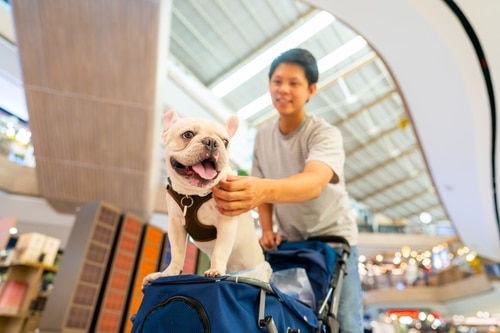When going away on a trip or planning a permanent move abroad, deciding what to do with our furry friends can be hard. Dogsitters and boarding kennels are always an option, as is leaving them in the care of trusted friends or family members, but what if you could bring them with you?
At Remitly, we’re committed to guiding immigrants and travelers as they move through the world. In this article, we’ll take a look at some top places to visit or consider relocating to with your pet and how to make the process as smooth as possible. We’ll also share tips for settling in and having the best time with your four-legged pal.
Most dog-friendly countries for pet owners
When it comes to traveling with your canine friends, it’s good to keep in mind the experience both of you will have when you arrive. Does the country have infrastructure like dog parks or pet-friendly travel laws? What about people’s general attitude towards dogs? All of it can impact how you and your pet feel in the new space.
Why choose pet-friendly destinations
Before traveling with your dog, you want to ensure that both of you will have an enjoyable trip. Part of this means minimizing stress. Choosing countries that are more pet-welcoming is the best way to do that, especially if it’s your first trip together.
Surrounding yourself with people who are more supportive and understanding of pet ownership also means you’re more likely to be in a safer environment. From strangers on the street, service workers at restaurants, or staff in your pet-friendly accommodations, every interaction will add to your travel experience.
If you’re looking to relocate, landlords in these countries may be more lenient about allowing pets in rental spaces. There will likely also be wider options for veterinary care and must-have amenities like pet stores.
What makes a country “dog-friendly”?
Dog-friendly countries are those that create space for dogs and their owners, whether legally, culturally, or both. Allowing furry companions in spaces like restaurants, cafes, parks, and public transport makes dog ownership easier for everyone. Countries that are more pet-friendly also have specific rules about animal care and welfare. All this has a secondary benefit of educating the populace and helping them feel more comfortable around dogs.
Top pet-friendly destinations
It’s a wide world out there, and not every country is as dog-friendly as the next. Here are our top recommended countries to visit or relocate to with your pet.
Canada: Pet-friendly amenities and outdoor attractions

Canada is a great destination for pet owners. Its cities tend to have a lot of places where dogs are typically welcome, like parks and cafes. Also, 60% of Canadian households own a dog, making them a very common pet, although they’re still outnumbered by cats. This means that Canadians in general are used to being around dogs and are quite comfortable around them.
Visitors and potential transplants alike are often drawn to the majestic nature found countrywide. Dogs are welcome in most of Canada’s national parks and green spaces, but they must be kept on a leash that is nine feet long at most. Dogs might not be allowed in some parts of the parks, or they could have special advisories or recommendations in place, so check before you go.
Overall, though, Canada redefines pet-friendliness, making it a great option for visiting or relocating dog owners and their pups. Before leaving, make sure to follow the latest entry requirements for dogs going into Canada.
Italy: A haven for dog owners

Italy is a wonderful place to be a dog owner. Though ownership rates are lower than in Canada, more than a third of Italian households include a dog. What’s more, the already friendly attitude toward pets is only expected to grow.
Getting around in Italy with a dog should be a piece of cake. Your four-legged friend is allowed on public transport, but you’ll be asked to put them on a leash and muzzle if they aren’t in a carrier. You’ll find that dogs are often welcome in indoor and outdoor areas, too, from bars and cafes to shopping centers and some supermarkets.
Entry requirements for pets into Italy are the same as in other European countries—find them here. However, specific rules will depend on where you’re coming from and your pet’s background.
France: Embracing pets in public spaces

Cats outnumber dogs in France; however, around a quarter of French households have a dog. It might not be quite as dog-friendly as Italy, but in many places, well-behaved pups can enter small shops and boutiques with their owners or sit outside on terraces. They may even be allowed to enter some dining establishments, though it’s best to check with waitstaff first.
You may also find that your furry friend is less likely to be welcomed in the most manicured city parks, but there is plenty of space to play in readily available on- and off-leash dog parks. These attitudes are changing, though. Many Parisian parks are now relaxing their bans on dogs, and public transport companies are starting to charge less for bringing pets on board.
Switzerland: Dog-friendly adventures outdoors

Like Canada, dog owners will likely be drawn to Switzerland for the incredible natural landscapes it offers. While it is a very dog-friendly country, only 12% of locals own a dog. This doesn’t mean that Swiss people don’t like dogs, but they are much less likely to approach one.
If you’re just exploring Switzerland with your pooch, there are some simple rules to remember:
- Always keep your dog on a short leash, even in natural spaces, as much of the country’s habitat is protected.
- Dogs aren’t typically allowed in shopping centers or restaurants, but they are welcome on terraces.
- When traveling within the country, you’ll need to pay an extra 50% of your ticket as a fee for any dog over one foot tall. You can choose between daily, monthly, or yearly passes according to your needs.
If you’re bringing a dog when you relocate, present them at Swiss customs on arrival to avoid any potential fines. Find the entry requirements here. Once in Switzerland, you must take them to your local vet to ensure they are properly registered. You’re required to pay a small, yearly tax and prove that your dog is properly trained.
Considerations for pet travel and relocation
Whether you’re just traveling or fully relocating with your canine companion, there are a lot of moving parts to consider. Though they can be a bureaucratic pain, checking all the boxes will allow you to legally and safely move about with your pet.
Pet travel essentials: passports, health certificates, and microchips
Before traveling, you’ll likely need a few things, which you should discuss with your vet.
- Pet passport: Many European countries have vet-issued, standardized pet passports. This is easier to acquire if you’re traveling within Europe or from a country with similar rules. In the United States, you’ll need to go through a USDA-approved veterinarian to get the proper documentation.
- Health certificates: These certificates are used to verify that your pet is not carrying any communicable diseases or parasites. Most countries are concerned about the risk of rabies and tapeworm. Results for the rabies test can take some time to get back, so consult your vet as soon as you make your travel plans.
- Microchips: You’ll typically be asked to show proof that your pet is microchipped with a standardized chip for identification and ownership verification purposes. This is generally good practice and is mandatory in some countries, though voluntary in others. If your dog doesn’t have one, your vet can quickly, easily, and painlessly place these chips for a small fee.
Understanding import regulations and restrictions
Each country has slightly different import rules and restrictions, though EU states all share similar requirements. Make sure you know if there are any pre-defined quarantine periods that may separate you from your dog upon arrival. Often, you can avoid these by having all of the necessary documents.
Doing everything you can to prepare for travel will set you and your dog up for a smooth and safe trip. When in doubt, consult a USDA-approved vet or search for information on pet entry requirements directly on official government websites for your destination. These standards are often set by departments or ministries of agriculture, so that can be a good place to start.
Transportation options for pets
You’re probably going to be flying commercial when traveling abroad. However, this may be more difficult for your dog depending on its size. Bigger canines will often need to be placed in the plane’s cargo hold, which can be a very stressful experience for them. If this is the route you decide to take, discuss ways to keep your pet comfortable and minimize stress with your vet.
You might be able to bring smaller animals onto the flight with you, but for longer flights, consider discussing how to do so safely with your vet. There may be ways to limit the possibility of accidents or stress during transit.
Alternatively, you could work with a pet shipping company to handle the process on your behalf. The International Pet and Animal Transport Association (IPATA) is a great resource for finding high-quality pet shippers who will help you get your dog where they need to go. Using a pet shipper can cut out the hassle of dealing with paperwork and the ins and outs of air travel for your dog.
Accommodations: Pet-friendly hotels and rentals
Before you arrive, do your research to ensure you’re staying at pet-friendly accommodations. Contact the landlord or owner directly so that you’ll know exactly what you need to do when you arrive with your dog.
Though many hotels and rentals are pet-friendly these days, you may still need to pay an extra fee when checking in. And if you’re looking for more permanent accommodation as you settle into your new home, be upfront with potential landlords. Reference letters from current landlords about your pet’s behavior may sway them into accepting you as a tenant or waiving pet fees.

Tips for a stress-free pet relocation
What can you do to prepare your pet—and yourself—for a long-term relocation abroad? Here are some simple tips to help you make the move:
Before the trip:
- Vet check-up: Prepare your pet by taking them to the vet well before your trip. Doing this will help you ensure your dog is healthy and fit for travel abroad.
- Medication: Get enough medication for your pet’s needs and carry a copy of the prescription in case you need a refill later on.
- Travel crate: Get a travel crate that meets IATA standards, meaning it’s strong, well-ventilated, and spacious enough for your dog to stand in, turn, and lie down comfortably. Also, crate train your pup beforehand to make the experience as stress-free as possible.
- Comfort items: Pack familiar toys and your dog’s favorite blanket to help them feel more secure.
During the trip:
- Comfort: Ensure your pup’s comfort by providing constant access to food and water. Try to keep noise levels down, too.
- Familiar scents: Surround your dog with familiar scents. You can use clean but well-used bedding for this.
- Medication or pheromones: With your vet’s advice, consider using medication or soothing pheromones to help your pet feel more at ease.
After the trip:
- Calm environment: Set up toys, climbing spaces, hidey holes, and comfortable places to lie down to create a calming atmosphere in your new place.
- Safety: Eliminate hazards like open windows, exposed wires, or toxic plants.
- Behavior: Watch out for signs of anxiety, such as hiding or excessive barking.
- Routine: Keep your feeding, walking, and playtime routine consistent to help your dog adjust faster.
- Explore: Take short walks around the area to help your pet get used to their new surroundings.
A pet-friendly travel experience
Traveling with your dog can be a wonderful experience for you both of you! Hopefully countries like these can give you an idea on where to go and how best to do so whether you’re traveling for fun or looking for a new home for the both of you.
FAQs
Which country keeps the most dogs as pets?
The United States has the most dogs in the world, with around 78 million dogs owned by Americans. However, Argentina has the highest rate of dog ownership, as 78% of households have dogs as pets.
Can you move internationally with a dog?
Yes. Just check the government regulations of your destination country well in advance to ensure you and your pet are well-prepared in terms of documentation and up-to-date vaccinations.
How hard is it to travel internationally with a dog?
This will depend on your dog’s size and temperament, as well as any agreements or lack thereof between your home and the destination country. If you’re just going on a short trip and not relocating permanently, ensure you have the information you need to return your dog to your home country after your trip. Also, research what to do if you need to suddenly cut your trip short.
